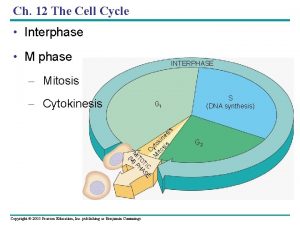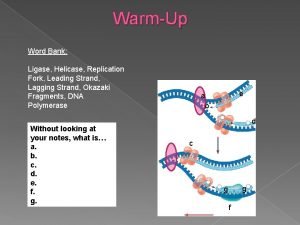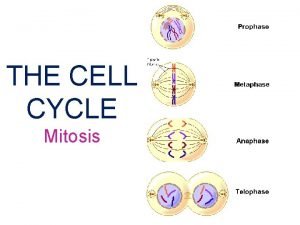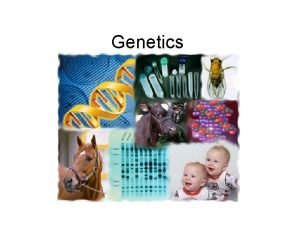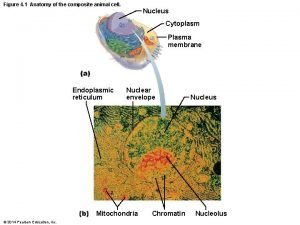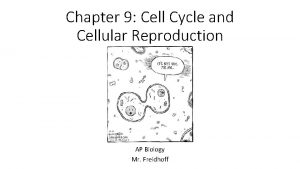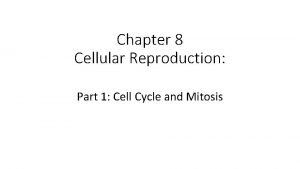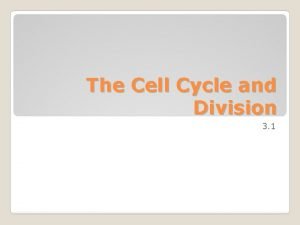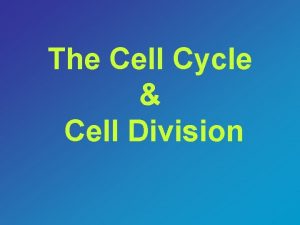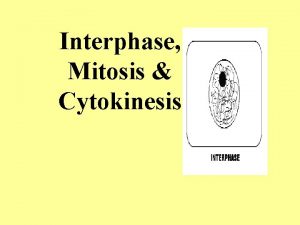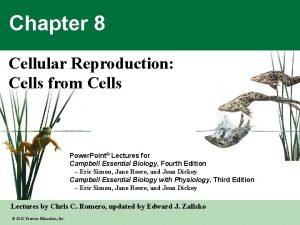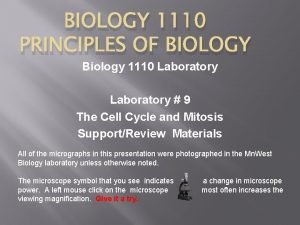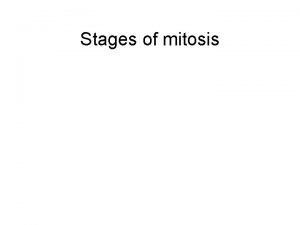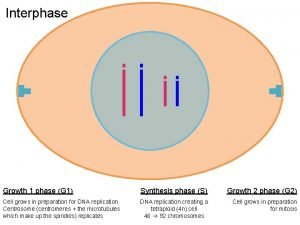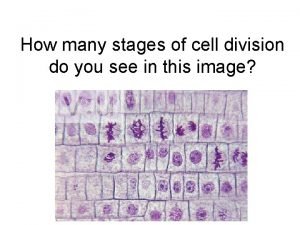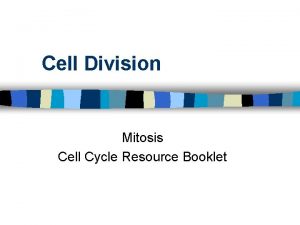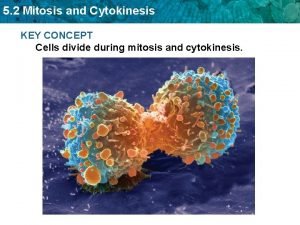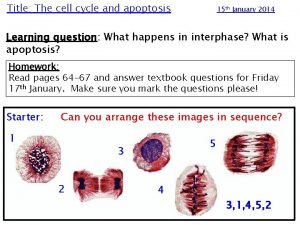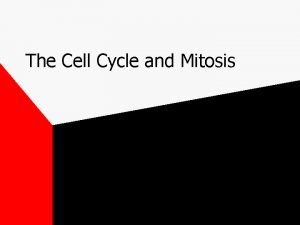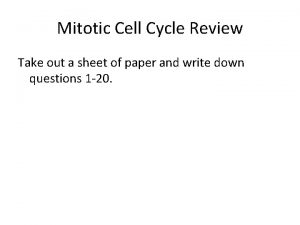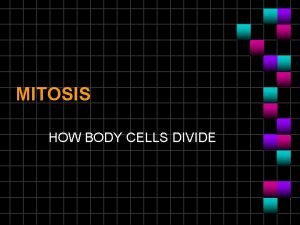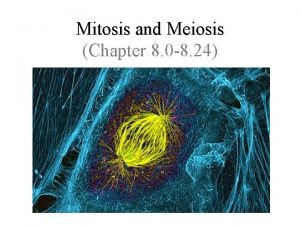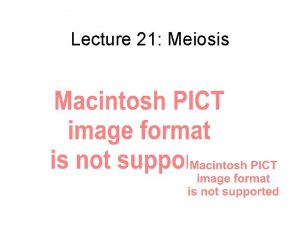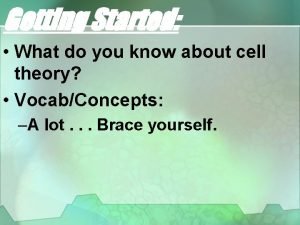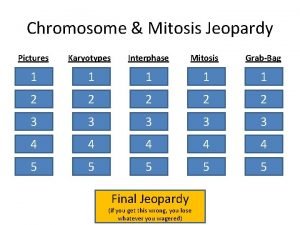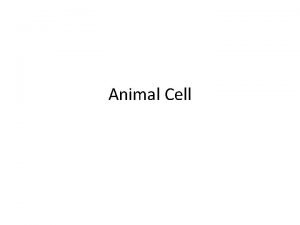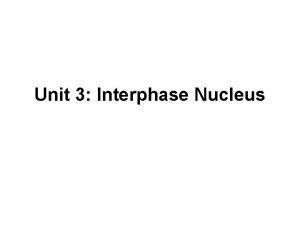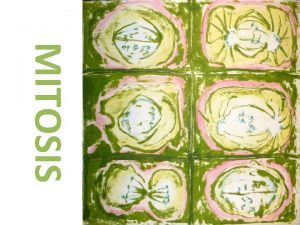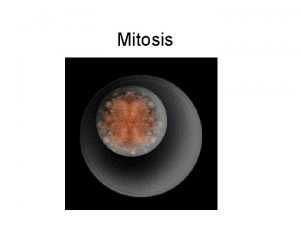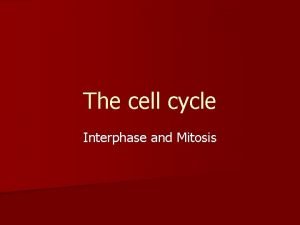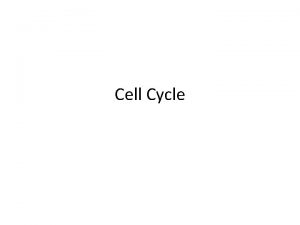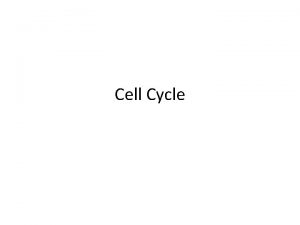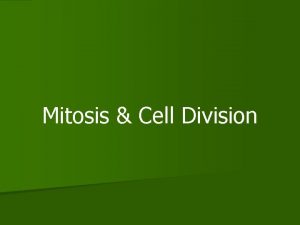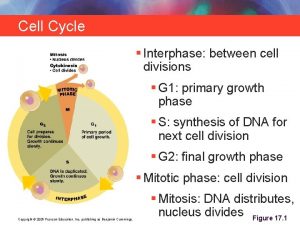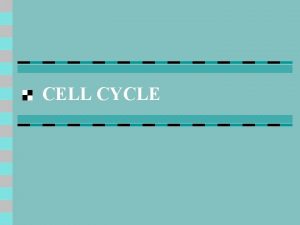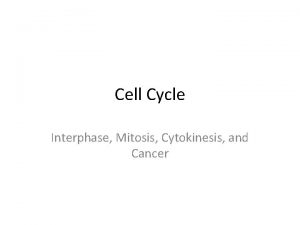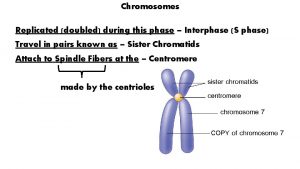What does the cell do during interphase Cell




































- Slides: 36

What does the cell do during interphase? (Cell Cycle Notes) 2. During what stage of the cell cycle does a cell divide its genetic material between two new cells? (Cell Cycle Notes) 3. What is chromatin? (Mitosis Vocabulary) 4. What are chromosomes? (Mitosis Vocabulary sheet) 1.

�Catalyst(5 minutes) �Mitosis and Cytokinesis (15 minutes) �Mitosis Manipulatives(10 minutes) �Review worksheet/Homework: When finish with manipulatives �Exit Ticket(5 minutes) �Homework: �Mitosis Review worksheet

�Donate canned goods (first period) until November 30 th! �Dojo review after break �Props

�Why do cells have to reproduce? �How do cells reproduce and replace dying cells and allow an organism to grow? �What is cancer and what causes cancer? �Why do children have features of both of their parents? �Why do siblings (except identical twins) have different features?

�SPI 3210. 1. 6 Determine the relationship between cell growth and cell reproduction. �SWBAT explain the purpose of mitosis �SWBAT summarize the events of each phase of mitosis �SWBAT identify the phases of mitosis based on a figure

Biology Unit 4 Lesson 4

�The cell cycle is how all non-reproductive cells grow, divide and reproduce �Skin cells, muscle cells, blood cells, etc. �There are three stages in the cell cycle �Interphase �Mitosis �Cytokinesis �At the end of the cell cycle, two identical daughter cells have been formed

�Key Point 1: The purpose of mitosis is to divide the cell’s nucleus and genetic material (DNA) among the two new daughter cells �Each cell must have a copy of the same DNA

� � There are four phases of mitosis Prophase Metaphase Anaphase Telophase

� Key Point 2: During prophase: �Chromatin condenses into chromosomes Each chromosome looks like an X �The nuclear membrane disintegrates (breaks down and disappears) Nuclear membrane= outer layer of nucleus �Spindle fibers form

� Key Point 3: During metaphase: �Spindle fibers connect the centrioles to the centromeres of each chromosome �Chromosomes line up along the middle of the cell Meta= middle

�Key Point 4: During anaphase: �Spindle fibers shorten, pulling the sister chromatids apart �Sister chromatids move towards opposite ends of the cell Ana=opposite

�Key Point 5: During telophase: �Chromosomes relax back into chromatin �The nuclear membrane reforms around the chromatin at each end of the cell

� Key Point 6: During cytokinesis: �Proteins pinch the middle of the cell at each end, forming a furrow �The furrow divides the cytoplasm, splitting the cell into two new identical cells �Plant cells form a cell plate instead of a furrow

�Italian Paparazzi Making All That Cash

What phase is each picture, and what is happening in each?

�http: //www. teachersdomain. org/ass et/tdc 02_vid_dnadivide/

�On your own or with a partner, �Sort the names of the phases into the proper order �Match each picture with the name of the correct phase of mitosis �Match the description of the phase with the correct phase of mitosis �Check your cards with Ms. M when complete

�When you finish your manipulatives: paper clip them and bring them to the front. �Grab a worksheet (everyone needs one) and start working on it.

� Answer the following questions: 1. Name the 4 phases of mitosis in the proper order. 2. What happens during prophase? 3. In what phase of mitosis do chromosomes line up along the middle of the cell? 4. What phase is shown below?

�ACT �Pg. Problem of the week 17 and 18 �Problems: 17 -21

�Catalyst(9 minutes) �Mitosis and Cytokinesis Flipbook (20 minutes) �Mitosis Review (10 minutes) �Homework: Eat good food.

�Donate canned goods (first period) until November 30 th! �Dojo review after break

�Why do cells have to reproduce? �How do cells reproduce and replace dying cells and allow an organism to grow? �What is cancer and what causes cancer? �Why do children have features of both of their parents? �Why do siblings (except identical twins) have different features?

�SPI 3210. 1. 6 Determine the relationship between cell growth and cell reproduction. �SWBAT explain the purpose of mitosis �SWBAT summarize the events of each phase of mitosis �SWBAT identify the phases of mitosis based on a figure

Biology Unit 4 Lesson 4

� On the front of each flap write the name of each stage of the cell cycle �Interphase �Mitosis: Prophase �Metaphase �Anaphase �Telophase �Cytokinesis

�On the inside of each flap, write a description of each stage. Interphase (definition, G 1, S, G 2) �Mitosis (definition)/Prophase (description) �Metaphase (description) �Anaphase (description) �Telophase (description) �Cytokinesis (definition)

�On the inside of your flipbook (the part NOT cut), draw a picture of each phase

� Activ. Expressions Questions � Activ Expressions reminders

� By yourself. � Quietly. � In your seats.

� 1. What type of cell goes through the cell cycle?

� 2. Put the following stages of mitosis in order. �A. Metaphase �B. Telophase �C. Prophase �D. Anaphase

� 3. In which stage of mitosis are the sister chromatids pulled to opposite ends of the cell? �A. Metaphase �B. Anaphase �C. Cytokinesis

� 4. Why does the cell cycle need to happen? (Think about what would happen to an organism if their cells do not reproduce. )

�Mitosis cell division produces A. Four genetically identical cell B. Two genetically identical cells C. Four genetically different cell
 During interphase a cell grows duplicate organelles and
During interphase a cell grows duplicate organelles and Why is cell division important
Why is cell division important Phases in interphase
Phases in interphase Interphase animal cell
Interphase animal cell Plant cell mitosis
Plant cell mitosis Cell in interphase labeled
Cell in interphase labeled Interphase cell
Interphase cell Composite animal cell
Composite animal cell Cell cycle
Cell cycle Interphase cell
Interphase cell Interphase cell
Interphase cell Stages of cell cycle
Stages of cell cycle Interphase prophase metaphase anaphase telophase
Interphase prophase metaphase anaphase telophase Dna scrunches up and chromosomes are first visible
Dna scrunches up and chromosomes are first visible Meiosis diagram with labels
Meiosis diagram with labels Non disjunction in meiosis 1 and 2
Non disjunction in meiosis 1 and 2 Interphase mitosis
Interphase mitosis Interphase
Interphase Whitefish interphase
Whitefish interphase Phase of mitosis
Phase of mitosis Growth 1 phase
Growth 1 phase Stages of cell
Stages of cell Pcb 3063 ucf
Pcb 3063 ucf Interphase
Interphase Interphase
Interphase Interphase to cytokinesis
Interphase to cytokinesis Interphase description
Interphase description Cell cycle
Cell cycle Interphase
Interphase Tetrad
Tetrad Mitosis meiosis animation
Mitosis meiosis animation Interphase
Interphase Meiosis function
Meiosis function Human life cycle
Human life cycle What's happening in interphase
What's happening in interphase Interphase pictures
Interphase pictures Hát kết hợp bộ gõ cơ thể
Hát kết hợp bộ gõ cơ thể


